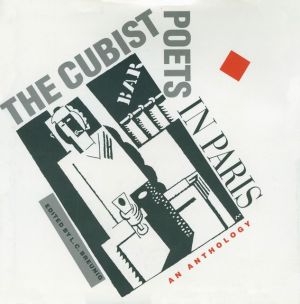The Cubist Poets in Paris: An Anthology
At the height of the Cubist movement in Paris, no fewer than fifteen significant poets kept company with the painters. “Every writer had his painter,” said Blaise Cendrars. “I myself had Delaunay and Léger, Max Jacob had Picasso, Reverdy Braque, and Apollinaire had everybody.” The painters illustrated the poets’ poems and painted their portraits; the poets wrote the painters’ praise and defended them in journalistic wars. They loaned each other money, gave shelter to each other in times...
Search in google:
At the height of the Cubist movement in Paris, no fewer than fifteen significant poets kept company with the painters. “Every writer had his painter,” said Blaise Cendrars. “I myself had Delaunay and Léger, Max Jacob had Picasso, Reverdy Braque, and Apollinaire had everybody.” The painters illustrated the poets’ poems and painted their portraits; the poets wrote the painters’ praise and defended them in journalistic wars. They loaned each other money, gave shelter to each other in times of need, inspired each other, and fortified each other’s resolve through thick and thin. The Cubist Poets in Paris evokes the capital city of Cubism in all its flamboyant bustle. It includes groups of poems by Guillaume Apollinaire, Pierre Albert-Birot, Blaise Cendrars, Jean Cocteau, Sonia Delaunay, Paul Dermée, Pierre Drieu la Rochelle, Charlotte Gardelle, Vicente Huidobro, Max Jacob, Marie Laurencin, Hélène Baronne d’Oettingen, Raymond Radiguet, Pierre Reverdy, and André Salmon. Each poem is presented in French and in English translation. Fifteen illustrations suggest the painters’ close ties with the poets, including works by Juan Gris, Giorgio de Chirico, and Léopold Suvage.Publishers WeeklyIn this exciting, bilingual anthology Breunig (Apollinaire on Art) offers selections from ``the dozen or so French poets who surrounded Picasso and his circle in Paris on the eve of and during the First World War''-from the well-known Guillaume Apollinaire and Blaise Cendrars to lesser appreciated talents such as Sonia Delaunay and Max Jacob. All worked closely with Picasso and Gris, defending the new cubist style, providing text for illustrations and borrowing-sometimes exchanging-techniques. French and English versions of the poems are presented on facing pages; illustrations demonstrate painter/poet collaborations. Breunig's introduction and bio-crit essays on featured poets are detailed and informative. Best is the opportunity to see the vitality of the Cubist poetic tradition: the playful ``visual poetry'' of Pierre Albert-Birot, words shaped self-reflectively on the page; the range and depth of Apollinaire; the deceptive simplicity of Pierre Reverdy, ``cubist poet par excellence.'' Photos. (May)
List of IllustrationsAcknowledgmentsIntroduction1Pierre Albert-Birot12Guillaume Apollinaire233Blaise Cendrars814Jean Cocteau1115Sonia Delaunay1336Paul Dermee1437Pierre Drieu La Rochelle1618Charlotte Gardelle1739Vicente Huidobro17910Max Jacob19911Marie Laurenein22912Helene d'Oettingen23913Raymond Radiguet25514Pierre Reverdy26915Andre Salmon287Selected Bibliography309Index317
\ Robert Motherwell“One can only marvel at the instinct of Parisian painters to keep their art in the hands of poets.”—Robert Motherwell\ \ \ \ \ Publishers Weekly - Publisher's Weekly\ In this exciting, bilingual anthology Breunig (Apollinaire on Art) offers selections from ``the dozen or so French poets who surrounded Picasso and his circle in Paris on the eve of and during the First World War''-from the well-known Guillaume Apollinaire and Blaise Cendrars to lesser appreciated talents such as Sonia Delaunay and Max Jacob. All worked closely with Picasso and Gris, defending the new cubist style, providing text for illustrations and borrowing-sometimes exchanging-techniques. French and English versions of the poems are presented on facing pages; illustrations demonstrate painter/poet collaborations. Breunig's introduction and bio-crit essays on featured poets are detailed and informative. Best is the opportunity to see the vitality of the Cubist poetic tradition: the playful ``visual poetry'' of Pierre Albert-Birot, words shaped self-reflectively on the page; the range and depth of Apollinaire; the deceptive simplicity of Pierre Reverdy, ``cubist poet par excellence.'' Photos. (May)\ \ \ Library JournalThis compilation, a synthesis of the collaboration between Cubist art and literature, draws mainly on the works of 15 Parisian Cubist poets of the first two decades of this century, including Guillaume Apollinaire, Max Jacob, and Andr Salmon, who, together with Picasso, formed the nucleus of the French Cubist movement. During the heyday of the movement, Cubist art and poetry interacted and developed remarkable stylistic parallels. Cubist painters portrayed poets and illustrated their poems; poets lauded the painters and supported their art in intellectual circles. The 15 illustrations by Cubist painters accompanying some of the poems suggest these close ties. The poets are introduced alphabetically; each poem is presented in its French original and in English translation on opposing pages. The editor limited his choices to early French and Francophone Cubist poets and painters, focusing more on their primary works than their theories, ideologies, or manifestos. Anglophone Cubists and others were purposely omitted. Recommended for all poetry collections.-Ali Houissa, Cornell Univ., Ithaca, N.Y.\ \








